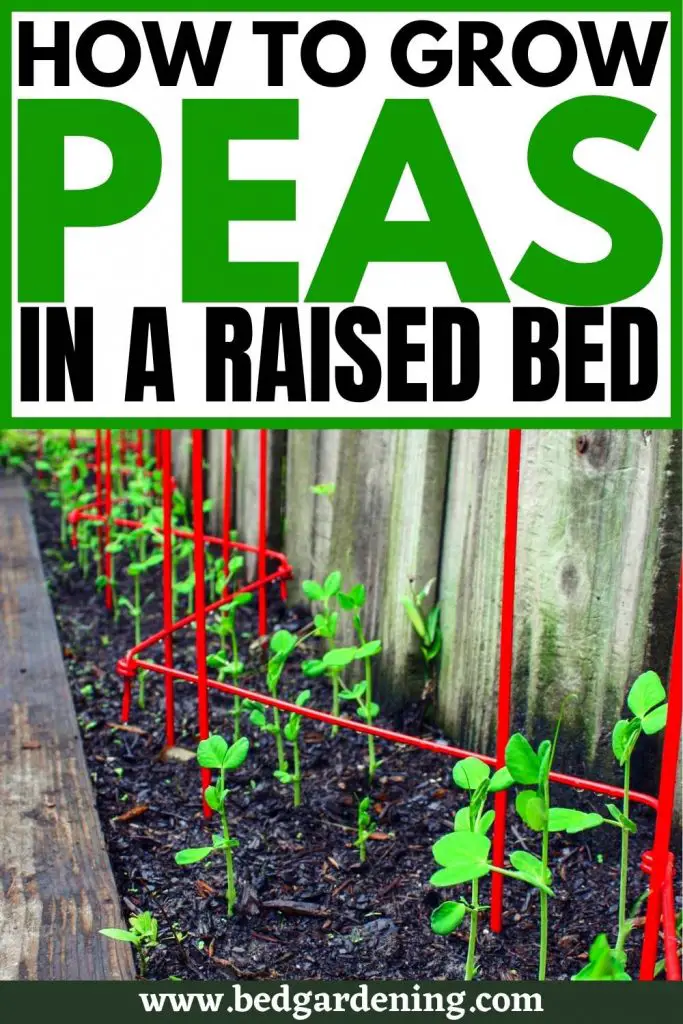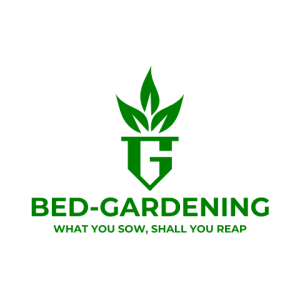The green vegetable peas are a good source of potassium, fibers, magnesium, vitamin A, C, and B 6 and iron. There are many ways to eat peas. You can stir fry them or cook them in soup or rice. They taste extremely delicious in any way. You can grow peas in spring with many vegetables.
Little maintenance is required for their growth. Disease-restraint varieties do not have any problem with pests and diseases. One pea plant does not provide you with a large number of peas. In a raised bed, you can cluster them. In this way, you can get an appropriate amount of peas. They like cool temperatures. The growing period of peas is within 45-60 days from seeding.
Read More: 5 Best Wooden Raised Garden Beds For Vegetables
Varieties of Peas
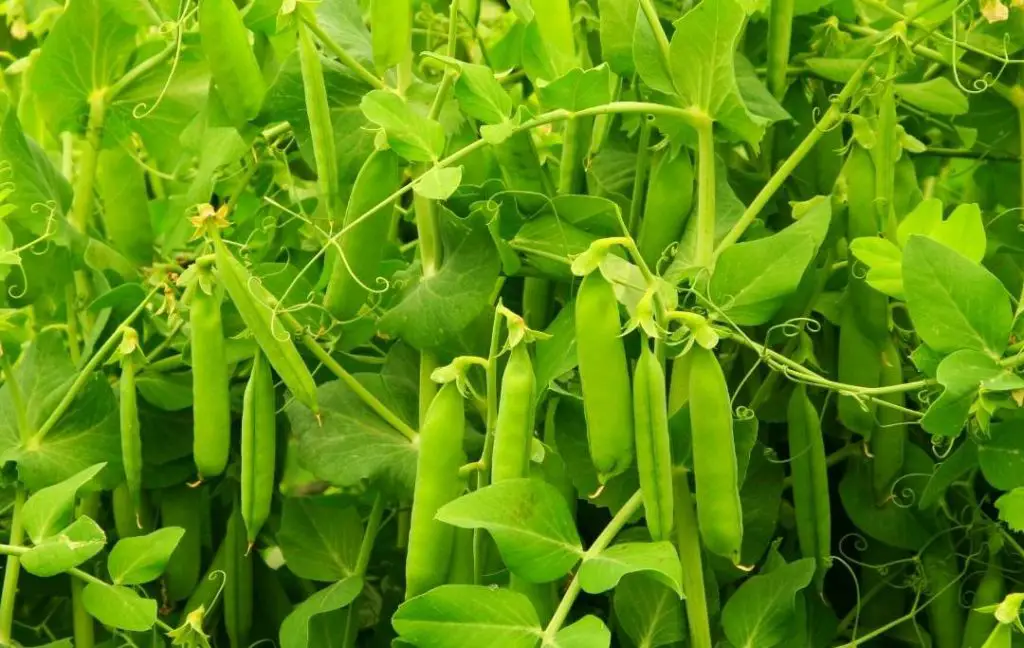
The varieties of the peas are different in taste, sweetness, and size. The maturity time is also different for each variety. You can get different varieties of peas by planting their seeds in your raised bed. It is the ability of raised beds to warm up faster than the surrounding ground. There are primarily three types of peas
- Garden Peas
- Snow Peas
- Sugar Snap Peas
Garden Peas
Garden peas have smooth, fleshy, and cylindrical green pods that are tough and fibrous. The garden pea has many cultivars like Spring Peas, Survivor Peas, Wando Peas, Garden Sweet, Thomas Laxton, Early Perfection, Lincoln Peas, and Little Marvel.
Snow Peas
The other name of snow peas is Chinese Peas, unlike garden peas, these peas have edible pods. You can easily grow them from the pods rather than the seeds. The different varieties of snow peas are Snowbird, Sugar Daddy, Gray Sugar, Avalanche, and Oregon Sugar Pods.
Sugar Snap Peas
Its shape is different from garden peas because it is more cylindrical. They are a hybrid of garden peas and snow peas. The sugar snap peas are very crispy and crunchy. They are also thick so you cannot cook this type of peas with their pod. the varieties of sugar snap peas are Sugar Bon, Sugar Snap, Super Snappy, and Sugar Ann,
Read More: 20 Cheap Raised Garden Beds DIY
When to Plant Peas?
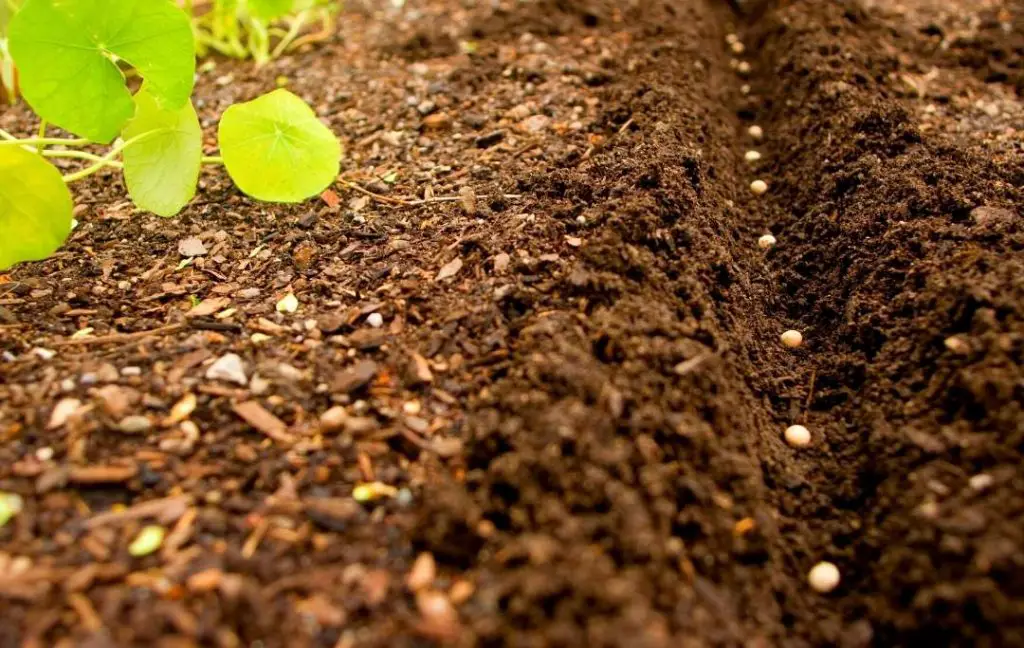
A little bit of care will provide delicious and nutritious peas. The best temperature for sowing peas is at least 45 Fahrenheit or 7-degree centigrade. You should sow seeds about 4 to 6 weeks before your last spring frost date. The cool weather is suitable for their growth even if snow does not harm your emerging peas plants.
If you are sowing them in late spring the height of temperature will create difficulties in their growth. After the winter, when you start planting again this is among the earliest plants you start each year.
The 2nd round of peas can be planted in the late summer or early fall, approximately 6 to 8 weeks before your first frost.
Read More: How to Grow Cucumber in Raised Beds
How to Plant Peas?
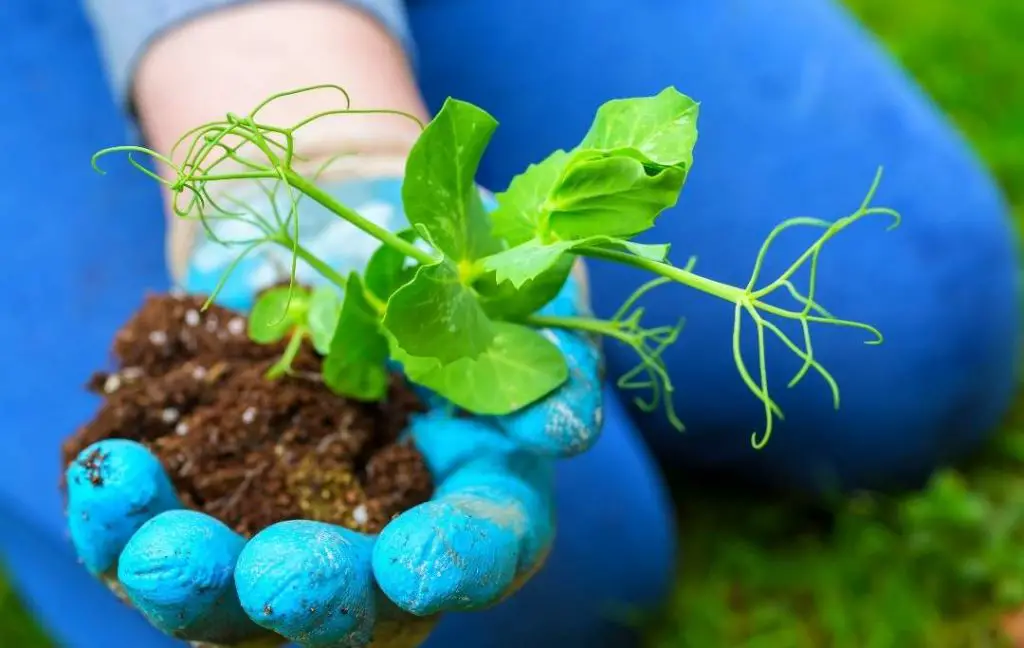
Choose the best spot for growing peas. This spot of your garden should get full sunlight with the soil that drains well. If they receive full sunlight their taste will be sweet as compared to those grown in part shade. Peas plants need less fertilizing so a little amount of compost is needed.
If you want to give a good start to your plant then add 2 to 3 inches of compost or manure to the soil so they will grow better as they get all the necessary nutrients from the soil. The basic requirements of the peas are phosphorus and potassium.
Don’t try to provide excess nitrogen as it will encourage foliage growth rather than flowers or pods. You can also add wood ashes and bone meal to the soil before planting the peas in a raised bed.
Select a location where vining peas can grow up on a trellis or other structure. It will support the plants to climb or immediately after emerging from the soil. Trellis is good for tall and vining pea varieties.
For better growth plant seeds 1 inch deep and try to create a distance 2 inches between two plants. The spacing between the rows should be 12 to 24 inches. If you want to get good production of your peas, before planting soak peas overnight in the water.
Read More: Best Irrigation System for a Vegetable Garden
Important Factors regarding Growing Peas
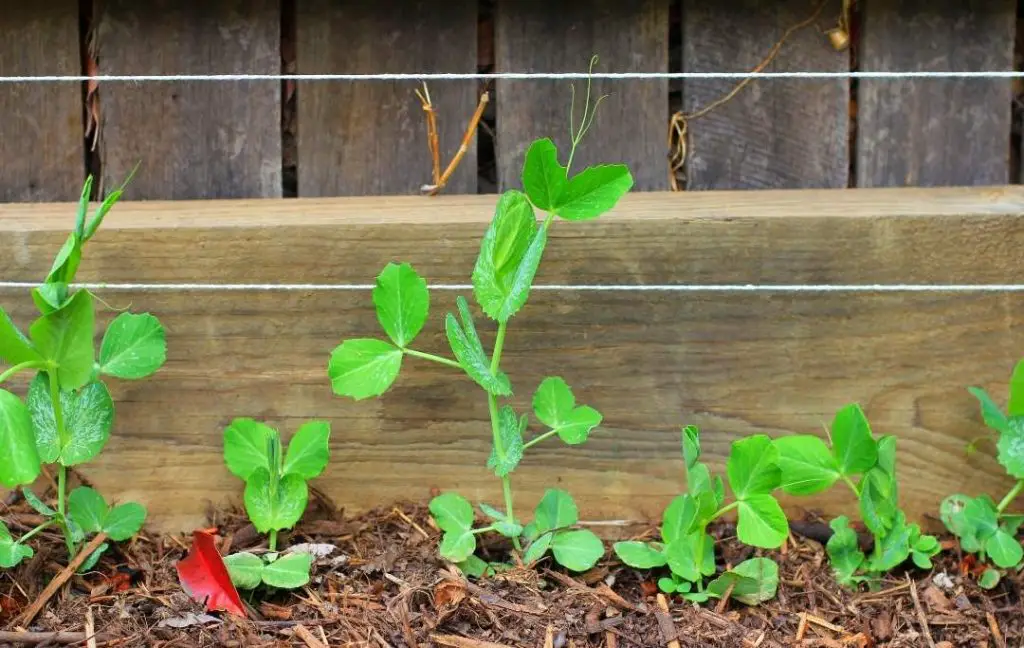
To grow Peas in a raised bed is an easy task, little care is required for this purpose. You need between 2 and 8 feet tall trellis so your vine easily climbs on fence or trellis. The height also depends on the variety of peas you are growing in your raised bed. There are some important factors that are necessary for the growth of peas like water, fertilizer, soil, mulching, compost, and temperature.
Water
Water is a transport medium for any plant, without water the nutrients and minerals would simply sit in the soil. Rich soil can hold more water for a long time as compared to poor soil. If the weather is dry, water them periodically and don’t let the plants dry out otherwise no pods will be produced for your kitchen.
At least one inch of water per week is required during flowering and pod production. As the temperature increases your plants need deeper water almost every day as water helps by keeping the vine cool through the water vapors which enter the plant from leaves.
Soil
Peas do not like moisture in the soil so well-drained soil is good for them. For this purpose add humans to improve drainage. Your plants would rot if you use poorly drained soil. Peas are nitrogen fixers and they will increase nitrogen levels in the soil, the companion plants will get benefit from it. The pH level of the soil must be between 5.8 to 7. Do soil amendment in fall so your soil can absorb easily.
Temperature and Sunlight
If you want to grow peas then try to sow seed in early spring because they can survive in a light frost. You can also get a second crop of peas in fall if you are living in an area with mild temperatures. But remember in the last few weeks of summer peas need proper care and attention. It is also noticeable that peas like 6 to 8 hours of direct sunlight daily.
Mulching
They like moist and cool soil. At least two inches of roots needed for mulching. You can use clean straws, chopped leaves, leaf mulch, and compost for this purpose. The happiness of peas vines depends on the mulching.
Read More: Best Annuals Flowers For Raised Beds
Trellis for Peas in Raised Beds
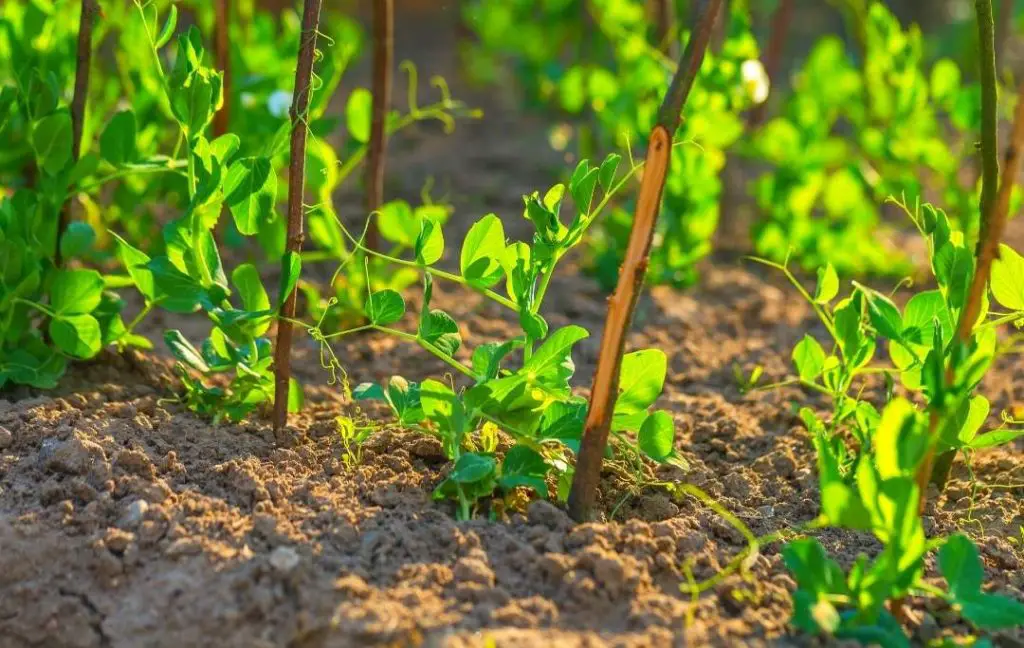
Peas plants need support for this purpose. The use of trellis is a great idea. If you are facing a problem of space shortage. It will help you to mitigate your distress and reach your goal of getting healthy peas. Naturally, peas need support to climb up. They will start climbing on other plants if you do not arrange a trellis.
Air Circulation is necessary for healthy pods of peas. Trellis helps to provide a better air supply to plants for respiration. You can easily harvest them due to trellis, hanging pods are manageable to pick. It prevents your pods from being attacked by pests and other animals like rabbits and slugs.
Decide the height of trellis according to your plants like short plants need small supports like fan trellis and tall plants need a large structure like a tall trellis. The right side of the support structure is an important task.
Peas’ height ranges from 3-6 feet and pea vines are very light. It means that it does not need a heavy-duty structure. You can make trellis at home, by using chicken wire, garden fencing, lightweight netting and it will cost you very cheap.
Train your pea vine to grow vertically when your vines grow taller tuck them into the trellis very carefully because vines of peas are very delicate.
Read More: 10 Amazing Raised Bed Vegetable Gardening Tips
Diseases and Pests
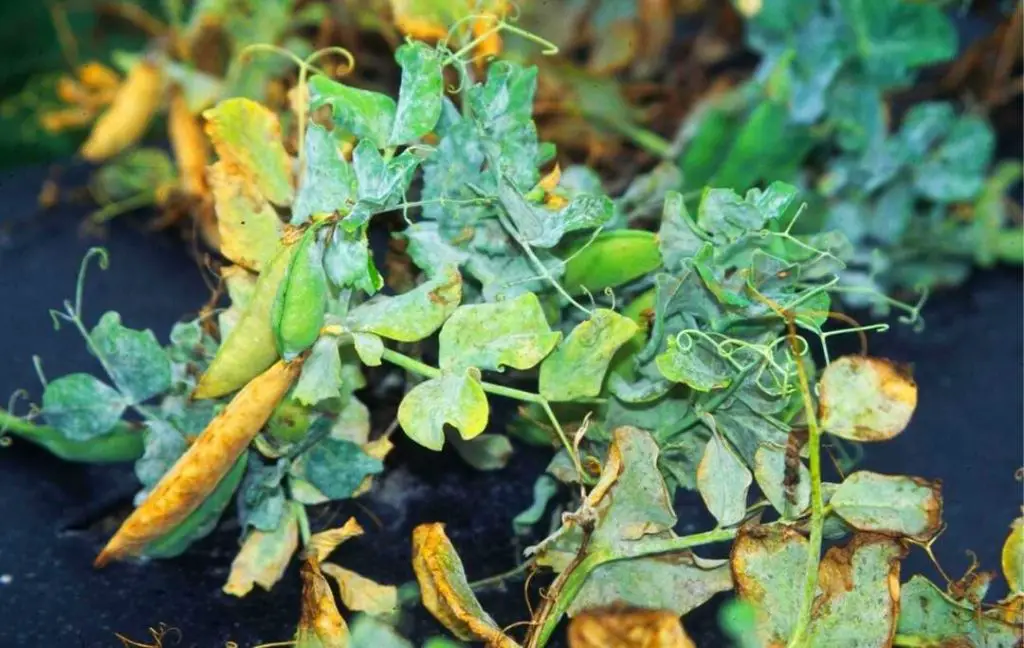
There are multiple common problems that any gardener will face while growing his own vegetable raised bed. Asocochyta blight, bacterial blight, root rot, and damping-off are some of the pea plant diseases. Aphids and pea weevils are the most common pests of pea plants.
You do your best effort but diseases may get into your raised bed. By adopting some precautions you can get rid of them. You can prevent your plant from disease and pest by removing infected plants, sanitize your tools, rotate crops, use well-drained soil, remove debris after harvesting and try to plant varieties resistant to the peas diseases.
Regular inspection of your plants twice a week will save you from pests and diseases.
Before using insecticide spray you should confirm what is the exact problem your plants are actually facing. Always try to avoid toxic ways to protect your plants, simple proper precautions will also help a lot to prevent peas vines.
Read More: How to Build a Raised Bed Along a Fence
Harvesting
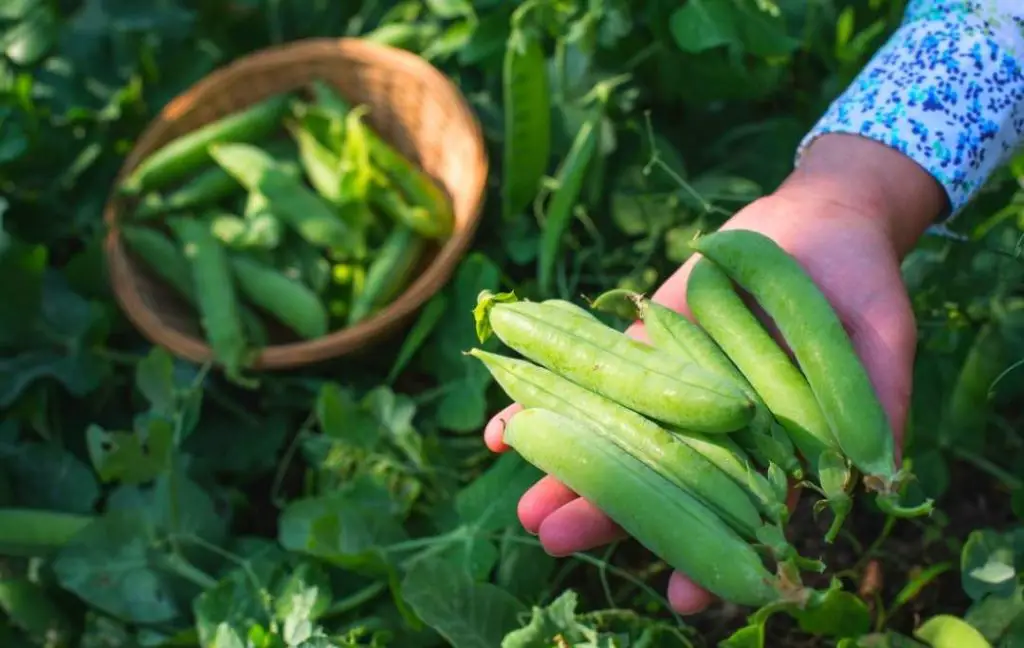
If you want to check the pod for harvesting you can do it by your eyes and feel it. The bright green color is a nice time for the picking if it changes to dull green, it shows you are late. Remember, frequent harvesting increases your production of peas.
Be careful while picking because peas do not have deep roots. Peace plants give you more production if you pick every other day. Increasing picking frequency will affect your yield. Different varieties have different maturity times.
Harvesting of Garden Peas
Within 50 days you are able to get garden peas from your raised bed. When the color of the peas is bright green it’s time to harvest them. The yellowish color shows that the taste of your peas become bitter. Remember, not harvest too early when the size of the peas are very small because they are not sweet. You can check the time of the harvest by squeezing pods between your fingers to test their plumpness and tenderness.
Harvesting of Snow Peas
This type of peas takes a long time to mature and can be harvested when their pod gets full length. It is essential to pick them regularly so you can get a sweet taste.
Harvesting of Sugar Snap Peas
Like snow peas, you should harvest them every 1 to three days. Pleasant weather is suitable for their good production and better health.
Read More: How To Make Row Covers For Raised Beds?
Storage
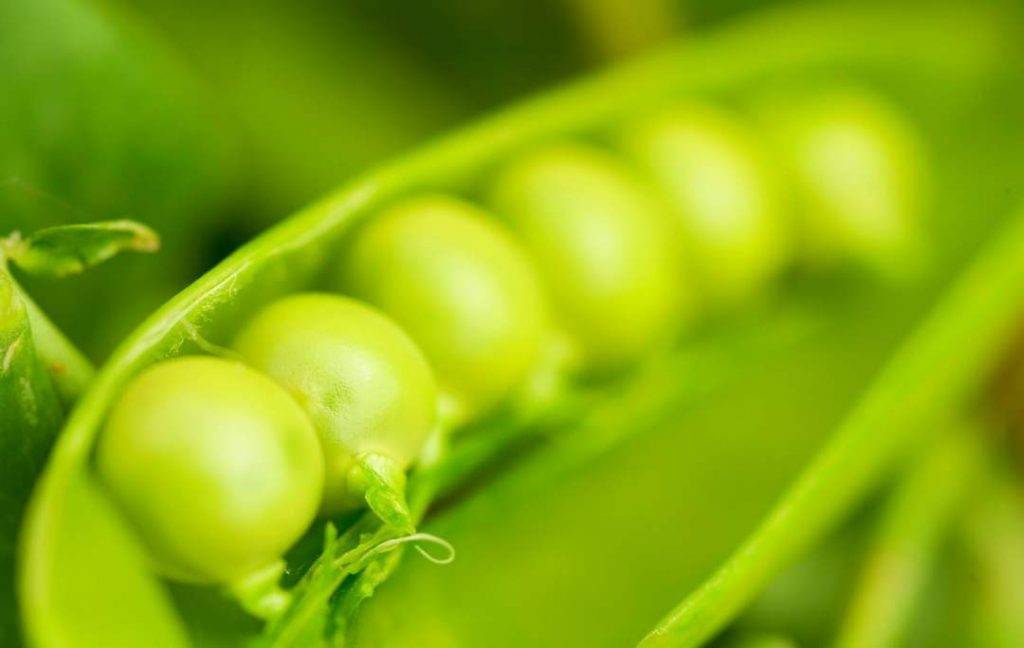
It is good to cook quickly after picking so you will get its tasty flavor and sugar. You can store peas by freezing or drying. During freezing, they lose but, but this is the best way of storing. The best way is to freeze them immediately after picking. Boil peas for 2 minutes, then plunge into the ice water for 2 minutes, after draining, pack them in a plastic bag or container and freeze them. You can use them for 9 months.
You can also store peas after drying in a dehydrator, use sealed containers for storing in the winter. The quality of the stored peas will be changed as compared to the fresh peas.
